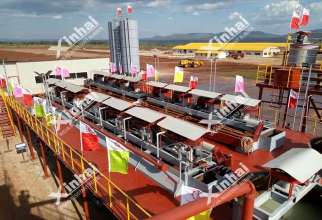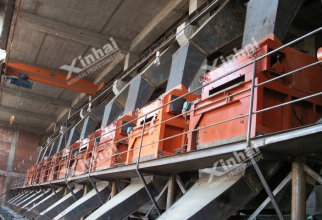-

Flotation process
The flotation process is a process in which ores, chemicals, and gas adhere to each other during the separation process. The adhesion (mixing) of the ores and chemicals can be achieved through the stirring tank, and then the air and air enter the flotation machine and have already How can minerals and medicines that are attached and mineralized to each other better adhere to each other, and then realize the process of separation as the foam rises.
-

Gold mine flotation process
The flotation process is one of the commonly used gold beneficiation methods. It is mostly used to process highly floatable sulfide minerals containing gold ores. Gold is often flotated into copper and lead concentrates, and then gold is extracted from these concentrates.
-

Gold mine carbon leaching gold technology
The gold mine carbon leaching process is also called the gold mine CIL (Carbon In Leach) process. This method is a process of adding activated carbon to the slurry and leaching and adsorbing gold at the same time. In the carbon leaching gold process, cyanide leaches the slurry and activated carbon. The two steps of adsorption are one step, which reduces losses and management costs at the same time. Compared with the traditional CCD process, it saves 66% of investment costs and is the main process for modern gold ore beneficiation.
-

Carbon-in-Pulp Gold Extraction Process
The gold extraction process from carbon slurry (CIP) is a non-filtered cyanide carbon slurry gold extraction process that uses activated carbon to directly absorb and recover gold from cyanide slurry. It is suitable for treating flotation gold concentrate or mercury amalgamation and gravity separation. Tailings muddy oxidized gold ore.
-

Gold mine heap leaching gold extraction process
The gold mine heap leaching gold extraction process has simple process, low energy consumption, less equipment configuration, low infrastructure investment and production costs, and is widely used. It is mostly suitable for processing low-grade gold ores such as oxidized ores, by-product ores mined during tunnel development or off-surface ores.
-

Gold ore gravity separation process
The gold ore gravity separation process is a process that uses the density and particle size differences of minerals to create suitable loose stratification and separation conditions through the combined action of medium fluids and various mechanical forces, thereby obtaining products of different densities or different particle sizes.
-

Hematite flotation process
Flotation is one of the common methods of hematite beneficiation. Compared with other beneficiation methods, flotation can effectively extract high-quality iron ore from fine-grained materials, thus providing high-quality raw materials for steel production.
-

Magnetite beneficiation process
Magnetite is mostly a granular aggregate with strong magnetism and wide distribution. According to the different types of iron-containing minerals, the stone can be divided into single magnetite and mixed mineral magnetite. When beneficiating minerals, it is necessary to determine a suitable process plan based on the properties of the ore.
-

Limonite beneficiation process
Limonite, as a weakly magnetic mineral, is a difficult-to-select iron ore. Because it is not significantly different from gangue minerals in terms of density, magnetism and floatability, and limonite has special properties such as unstable chemical composition, unstable iron content, large changes in moisture content, and easy over-crushing during the grinding process. , so the mineral processing methods are different.
-

Siderite beneficiation process
Siderite is a common carbonate mineral with low iron content and usually appears as granular, earthy or dense massive aggregates. As a common weakly magnetic iron ore, siderite beneficiation is difficult.
-

Chromite beneficiation process
There are about 30 types of chromium minerals that have been discovered, but the only chromium mineral with industrial value is chromite, which is used to produce ferrochromium alloys, metallic chromium, chromium magnesia bricks, special refractory materials, sodium dichromate, and chromium compounds. primary sources.
-

Ilmenite beneficiation process
In nature, ilmenite resources can be divided into two categories: primary ilmenite and sandy ilmenite according to actual conditions. Different characteristics of ilmenite ore also put forward different requirements for titanium.
-

Manganese ore beneficiation process
Manganese ore is one of the main resources for obtaining manganese and iron. Among manganese ore resources, 73% of manganese minerals contain high iron elements, and the particle sizes of manganese and iron minerals are relatively fine, with obvious Iron and manganese are isomorphic, and the degree of monomer dissociation is difficult, making the selection difficult. Therefore, the factory adopts a variety of joint beneficiation methods to select the Biemeng iron ore. At present, the main separation methods for iron-manganese ore include gravity separation, magnetic separation, flotation, roasting and fire enrichment.
-

Pyrite beneficiation process
Pyrite mainly includes pyrite, marcasite and pyrrhotite, which are widely found in various types of mineral deposits, among which pyrite is very common. At present, sulfur is relatively mature, and flotation is generally the main method, supplemented by gravity separation. Depending on the properties of the ore, different mineral processing methods can be used.
-

Copper sulfide ore flotation process
Chalcocite, chalcopyrite, pyrite, and pyrrhotite are several important ores in copper sulfide ores. In addition to copper and sulfur, copper sulfide ores also contain a large amount of beneficial Elements such as gold, iron, molybdenum, silver and other elements. The copper sulfide ore beneficiation process is also mainly flotation, and the flotation process is relatively simple.
-

Copper oxide ore flotation method
The quality of copper oxide is relatively low, mainly due to the serious mudification phenomenon and high oxidation rate. In terms of mineral processing, copper oxide ore is relatively difficult to be separated. At present, the main beneficiation method of copper oxide is flotation. According to the copper oxide ore The different properties can be divided into direct flotation method and sulfide flotation method.
-

Chalcopyrite flotation process
Chalcopyrite is a copper-iron sulfide mineral that often contains trace amounts of gold, silver and other minerals. Chalcopyrite has good self-induced floatability and collector-induced floatability, and has good hydrophobicity in weakly alkaline and neutral environments. Therefore, flotation is often used in separation treatment.
-

Lead-zinc sulfide ore flotation process
Under normal conditions, the flotation process of lead-zinc ore mainly includes two types: traditional flotation process and potential controlled flotation process. Among them, transmission flotation process includes priority flotation, mixed flotation, equal flotation and asynchronous flotation. Four techniques.
-

Lead oxide zinc ore flotation process
Lead-zinc oxide ore has a high oxide content, its performance is relatively fragile, and it is easily broken during mining. Moreover, this mineral has a complex composition and is difficult to separate. Currently, the common separation process mainly includes sodium oxide sulfide flotation. method, sulfur sulfide flotation method, flocculation flotation method, heavy flotation combined separation method, etc.
-

Fluorite ore flotation process
The flotation process is the main beneficiation method for fluorspar ore. According to the different associated minerals, fluorite ore can be divided into quartz-type fluorite ore, calcite-type fluorite ore, barite-type fluorite ore and polymetallic symbiotic fluorite ore, etc. Each mineral has different properties, and its flotation The process is also different.
-

Phosphate rock flotation process
The commonly used process for phosphate mineral beneficiation is mainly flotation. The effect of flotation depends on the interaction between mineral particles and bubbles in the water medium. It is also coupled with a reasonable flotation agent addition system, flotation operating conditions, and flotation Equipment performance, etc. improve the interaction between bubbles and mineral particle surfaces.
-

Nickel ore flotation process
The main types of nickel ores are copper-nickel sulfide ores and copper-nickel oxide ores, among which copper is the main impurity in nickel minerals. The flotation process is mostly suitable for copper-nickel sulfide ores in nickel ores. The metal minerals in this type of nickel ore mainly include pyrrhotite, pentlandite, and chalcopyrite, followed by magnetite, pyrite, ilmenite, chromite, graphene, copper blue, and chalcopyrite. Copper ore, bornite and platinum group minerals, etc.; gangue minerals are mainly olivine, pyroxene, plagioclase, talc, serpentine, chlorite and mica.
-

Barite flotation process
Barite is commonly separated by flotation in mineral processing operations. This kind of ore is often associated with fluorite, calcite, quartz and other salt minerals. The mineral composition can be divided into two categories: barite-quartz-calcite type ore and barite-fluorite type ore.
-

Graphite ore flotation process
Graphite ore is divided into three categories according to different crystal forms: dense crystalline graphite, cryptocrystalline graphite and flake graphite ore. Among them, flake graphite ore is suitable for flotation. After multiple grinding and flotation, it can be Obtain higher grade graphite concentrate.
-

Lithium ore beneficiation method (lithium extraction technology)
Lithium has the advantages of high specific heat, high electrical conductivity, and strong electrochemical activity, and is widely used in energy, materials and other fields. There are more than 150 kinds of lithium minerals and lithium-containing ores that have been discovered in nature, but the only ones that can effectively extract lithium are spodumene, lepidolite, lithium mica, lithium lithium aluminite and lithium feldspar.
-

scheelite flotation process
Most scheelites are sandstone type and composite type (vein disseminated type-greytzite skarn composite type), which are often associated or symbiotic with a variety of non-ferrous metal minerals such as molybdenum and bismuth. The useful minerals are embedded in fine grain sizes and are mostly in the form of Disseminated and embedded in the ore. Generally, scheelite has a fine crystal size and good floatability, so flotation is often used to recover scheelite.
-

Rare earth ore flotation process
Rare earth minerals refer to the collective name of 17 kinds of metal chemical elements, which have high chemical activity and easily form compounds with other elements. In nature, rare earth minerals mainly exist in the form of minerals. The chemical properties of the elements are very similar, which makes them often coexist in nature and difficult to separate.
-

silver ore dressing process
Common silver ore types include independent silver ore, in which silver is the main mineral and often coexists with quartz, calcite and other gangue; associated silver ore, silver is associated with metal minerals such as copper, lead and zinc, with low content and uneven distribution; complex silver ore, silver coexists with a variety of metal minerals, with complex composition, diverse mineral composition, complex crystal structure and a wide range of silver mineral distribution.
-

Tin ore dressing process
The types of tin ore mainly include cassiterite, sulfide tin ore and skarn tin ore. Among them, sulfide tin ore contains a high sulfur element and often coexists with a variety of sulfide minerals. Generally, the beneficiation of tin ore is determined according to the type and characteristics of the ore.
-

Cobalt ore dressing process
Cobalt is a metal element, often coexisting with nickel, copper, etc. Common cobalt-containing minerals include cobalt pyrite, skutterudite, arsenic cobaltite, arsenic cobaltite, etc. The mining, dressing and refining process of cobalt ore is relatively complicated, and a variety of physical and chemical methods are required to improve the purity of cobalt.
-

Quartz sand beneficiation process
Quartz sand is also called silica sand. The purpose of beneficiation is mainly to purify and remove small or trace impurities in quartz sand to achieve the purity required by various industries. Commonly used quartz sand beneficiation methods include: pre-selection desliming, scrubbing, magnetic separation, flotation, acid leaching, etc.
-

Wolframite ore beneficiation process
Wolframite is an oxide mineral of the monoclinic system. There are three types of wolframite, tungstenite and wolframite. The mineral density is relatively high, brittle and easy to be crushed. In the mineral processing process, gravity separation is often used. Method is the main means. However, some fine-grained wolframite or wolframite fine mud minerals need to be separated by flotation. In addition, wolframite has a certain weak magnetism and can be purified by strong magnetic separation during separation.
-

Molybdenum ore dressing process
The most widely distributed and industrially valuable molybdenum ore is molybdenite (MoS2). About 99% of the world's molybdenum production is obtained from molybdenite. my country is rich in molybdenum ore resources, accounting for about 25% of the world's total molybdenum, ranking second in the world.




 Consult
Consult Message
Message
